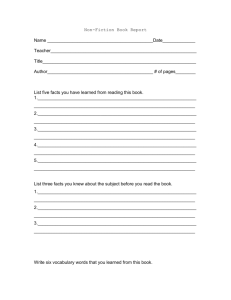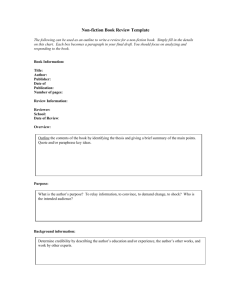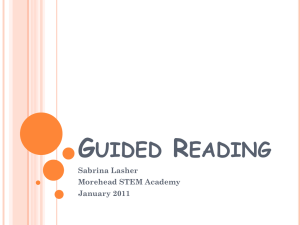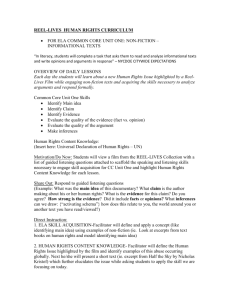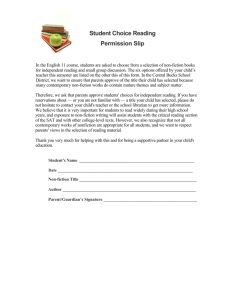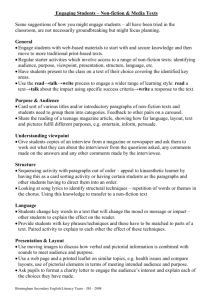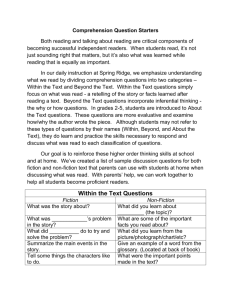Health Academy Chemistry
advertisement
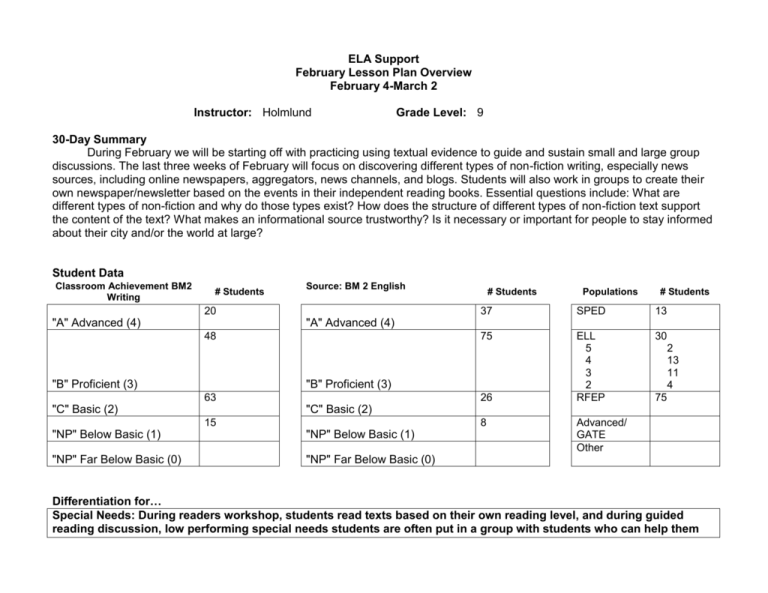
ELA Support February Lesson Plan Overview February 4-March 2 Instructor: Holmlund Grade Level: 9 30-Day Summary During February we will be starting off with practicing using textual evidence to guide and sustain small and large group discussions. The last three weeks of February will focus on discovering different types of non-fiction writing, especially news sources, including online newspapers, aggregators, news channels, and blogs. Students will also work in groups to create their own newspaper/newsletter based on the events in their independent reading books. Essential questions include: What are different types of non-fiction and why do those types exist? How does the structure of different types of non-fiction text support the content of the text? What makes an informational source trustworthy? Is it necessary or important for people to stay informed about their city and/or the world at large? Student Data Classroom Achievement BM2 Writing # Students Source: BM 2 English 20 "A" Advanced (4) # Students Populations # Students 37 SPED 13 75 ELL 5 4 3 2 RFEP 30 "A" Advanced (4) 48 "B" Proficient (3) "B" Proficient (3) 63 "C" Basic (2) 26 2 13 11 4 75 "C" Basic (2) 15 8 "NP" Below Basic (1) "NP" Below Basic (1) "NP" Far Below Basic (0) "NP" Far Below Basic (0) Advanced/ GATE Other Differentiation for… Special Needs: During readers workshop, students read texts based on their own reading level, and during guided reading discussion, low performing special needs students are often put in a group with students who can help them stay on track. Students with special needs are allowed to ask for time extensions in order to complete writing assignments. Further, students with special needs are encouraged to advocate for themselves by letting the instructor know when they might need assistance. English Language Learners: During readers workshop, students read texts based on their own reading level, and during guided reading discussion, students discuss a text with students of similar reading skill. Gifted/ Advanced: During readers workshop, students read texts based on their own reading level, and during guided reading discussion, students discuss a text with students of similar reading skill. Week: February 48 February 11-15 Standard(s): Objectives: G8.W.2.2.b: Write responses to literature Connect the student's own responses to the writer's techniques and to specific textual references. G8.L.2.2.d: Deliver oral responses to literature Support judgments through references to the text, other works, other authors, or personal knowledge Students will use concrete details and examples from text in writing responses in their reading journals. G7.R.2.1: Understand and analyze the differences in structure and purpose between various categories of informational materials (e.g., textbooks, newspapers, instructional manuals, signs). Students will evaluate different types of nonfiction texts and their distinctive features. Students will used concrete details and examples from text to ask text based questions and make text supported claims in small group discussions. Agenda: Materials: Assessments: As a class read about the benefits of reading in Dana Goia’s article – and others – to practice having evidence based discussions. Independent Reading Books Guided Reading Articles Exit quiz on guided reading/fake reading. Readers Workshop: Mini Lessons cover fake vs real reading and using evidence to guide written responses and group discussions. Independent Reading and Response In Guided Reading, students practice reading and finding text based questions to guide their discussions. Readers Workshop: Mini Lessons will cover types of non-fiction and the structural features of non-fiction. Independent Reading and Response Students will begin working in collaborative groups to create a newspaper/newsletter. Non-fiction vocabulary. Observations of discussion groups. Check student journal entries. Independent Reading Books Guided Reading Articles Several News Sources (LA Times, NY Times, CNN, etc) Exit quiz on types of nonfiction and their features. Students turn in organizer for what parts of the newspaper/newsletter they will be completing. Exit quiz on non-fiction vocabulary February 19-22 G6.R.2.1: Identify the structural features of popular media (e.g., newspapers, magazines, online information) and use the features to obtain information. Students will know and identify the important features of traditional and modern electronic news sources. Readers Workshop: Mini Lessons will cover choosing news sources and the structure of news articles. Independent Reading and Response Students will continue working in collaborative groups to create a newspaper/newsletter. Independent Reading Books Guided Reading Articles Several News Sources (LA Times, NY Times, CNN, etc) Quiz on structures of news/popular media writing. Independent Reading Books Guided Reading Articles Several News Sources (LA Times, NY Times, CNN, etc) Quiz on finding important information. Observations of collaborative groups. Exit quiz on news vocabulary News vocabulary. February 25-March 1 G6.W.1.4: Use organizational features of electronic text (e.g., bulletin boards, databases, keyword searches, e-mail addresses) to locate information. Students will find and evaluate information in modern news sources. (March 4-8: Students will use relevant and credible information from modern news sources to write an essay discussing a current issue). Readers Workshop: Mini Lessons will cover searching texts for information and evaluating news sources for bias. Independent Reading and Response Students will peer edit their articles and publish their newspaper/newsletter. Students submit group newsletter/paper. Composition book check for individual reading responses. Types of non-fiction: News and other journalism, essays, journals, diaries, documentaries, histories, scientific papers, photographs, biographies/autobiographies, textbooks, travel books, cook cooks, technical documentation, user manuals, reference works (dictionaries, encyclopedias, thesauri), letter Features of non-fiction: Documentation/proof/evidence can come in many forms, including pictures captions, charts or graphs, statistics, witness statements, interviews, research studies, personal experience Generally more textual features than novels: pictures, charts/graphs, headline/title, subtitles, section titles or headings, glossary and index, footnotes/endnotes Skills for non-fiction: Skimming How to skim effectively o Look at text features: Titles, headlines, subheadings Pictures and captions Charts or graphs Knowing where the information is in different types of non-fiction news: beginning of article textbooks: beginning of chapter/section, bold words, section/chapter summaries News sources: 1. Newspapers: paper or online a. local: Long Beach Press-Telegram, LA Times Local b. national: LA Times, NY Times, Washington Post, USA Today, Wall Street Journal 2. Magazines: in print and online a. News only: Newsweek b. Popular: 3. TV news: on TV or online a. News only: CNN, CSPAN, FOX News, CNBC, ESPN (sports news) b. Major networks with news: NBC, CBS, ABC, FOX 4. Radio news: on radio or online 5. Popular news: Huffington Post, TMZ News article structure: 1. Headline: a phrase or sentence used to catch readers’ attention. a. Byline: name the author and location. 2. Subhead or Billboard: a brief summary of the article that can either be one to two sentences below the headline or in a box on the side of the page; it could also be a few bullet points in the side box. 3. Inverted Pyramid Structure: the most important information in a traditional news story comes first. a. The most newsworthy information. i. Lead: the first sentence should contain a very brief summary of the story. ii. The lead is followed by a more full explanation that answers the 5 Ws – who, what, where, when, and why – and may also answer how. b. Important details. i. The rest of the article includes supporting materials, such as quotations from individuals interviewed or details about the event being reported. c. Other general or background information. i. Putting dates in order for non-fiction Identifying target audiences and what that means for the text
